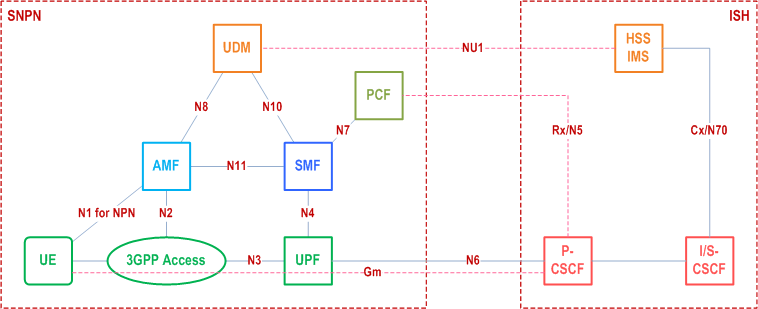Content for TS 23.228 Word version: 18.6.0
1…
3…
4…
4.2.4…
4.3…
4.4…
4.13…
4.16…
5…
5.2…
5.3…
5.4…
5.4.7…
5.4.8…
5.4a…
5.5…
5.5.3…
5.6…
5.6.3…
5.7…
5.7.3…
5.7.5…
5.7.8…
5.8…
5.10…
5.11…
5.11.3…
5.11.3.3
5.11.3.4
5.11.4…
5.11.5…
5.11.5.3…
5.11.6…
5.12…
5.16…
5.16.2…
5.19…
5.20…
A…
E…
E.2.2…
G…
G.5…
H
I…
J…
K…
L…
M…
M.3…
N…
P…
Q…
Q.2.5…
R…
S…
T…
U…
U.2…
V…
W…
X…
Y…
Z…
AA…
AA.3…
AB…
AC…
AC.7…
AC.7.2…
AC.7.2.2
AC.7.2.3…
AC.7.4…
AC.9…
AB Support of IMS in SNPN
AB.1 IMS in SNPN
AB.1.0 General
AB.1.1 SNPN deployed IMS
AB.1.2 IMS services provided by independent IMS provider
AB.1.2.1 General
AB.1.2.2 Support for Emergency Services
AB.1.2.3 SNPN Support for Multiple Independent IMS Providers
...
...
AB Support of IMS in SNPN |R17| p. 364
AB.1 IMS in SNPN p. 364
AB.1.0 General p. 364
Annex AB describes deployment options for SNPNs to enable access to IMS services for SNPN subscribers. Two potential deployment options are described below.
For the purpose of this Annex, an IMS Subscription Holder (ISH) identifies the administrative domain holding the IMS subscription for a UE subscribed to receive IMS services.
The ISH can be the same or independent from the SNPN domain which deploys the 5GS. In the case the ISH is different from the administrative domain of the SNPN, the UE needs to have two separate subscriptions, one for accessing the 5GS of the SNPN (provided by the SNPN or Credentials Holder (CH) as defined in TS 23.501) and one for accessing IMS services provided by the ISH. The UE needs to be successfully authenticated in each domain, using the appropriate subscription, before able to receive IMS services.
AB.1.1 SNPN deployed IMS p. 364
In this option, the SNPN deploys its own IMS used by subscribers with a SNPN 5GS subscription. The SNPN and the ISH belong to the same administrative domain. In this deployment scenario, either USIM/ISIM or IMC is used to authenticate and authorize a UE for accessing IMS services.
AB.1.2 IMS services provided by independent IMS provider p. 364
AB.1.2.1 General p. 364
This option is applicable to SNPNs not providing own IMS services. It enables the SNPN to use IMS services from an independent IMS provider, e.g. PLMN or another entity, which is the ISH, providing IMS services for SNPN subscribers.
It is assumed that the SNPN has an agreement with the ISH. This agreement describes e.g. P-CSCF address provisioning and security aspects for all standardized reference points that are implemented between both administrative domains.
In this deployment option either IMC or USIM/ISIM credentials are used to authenticate and authorize a UE for IMS services.
The UE holds an association between an SNPN subscription and the corresponding IMS subscription to ensure proper credentials are used to access SNPN and IMS services in this deployment option. The mechanism how this association is stored in the UE is out of scope of 3GPP.
A potential architecture for this deployment option is depicted in Figure AB.1.2.1-1.

AB.1.2.2 Support for Emergency Services p. 365
Support for Emergency Services requires that the SNPN, based on an agreement with the ISH, broadcasts IMS Emergency Services support as described in TS 23.501.
AB.1.2.3 SNPN Support for Multiple Independent IMS Providers p. 365
In order for an SNPN to enable IMS services to be provided via multiple independent ISH, it is required that for every SNPN subscriber, the IMS DNN stored in UDM of the SNPN contains the information, which is used to identify the corresponding ISH, e.g. ISH domain name is encoded as part of IMS DNN. At PDU session setup, the SMF selects the P-CSCF of the ISH based on clause 5.16.3.11 and clause 5.16.3.4 of TS 23.501.
The CH and SNPN need to agree that the AMF in SNPN that receives the subscription information that includes the IMS DNN and contains information to identify the corresponding ISH, is able to determine the ISH and therefore derive correctly the IMS voice over PS Session Supported Indication as defined in clause 5.16.3.2 of TS 23.501.